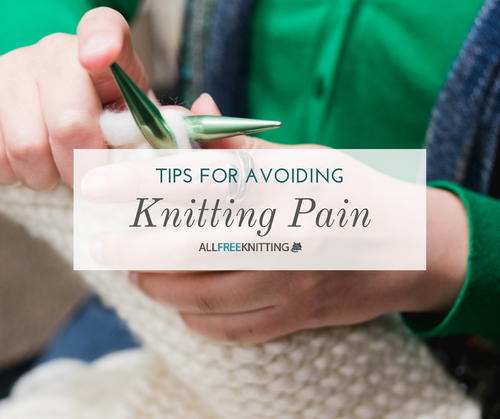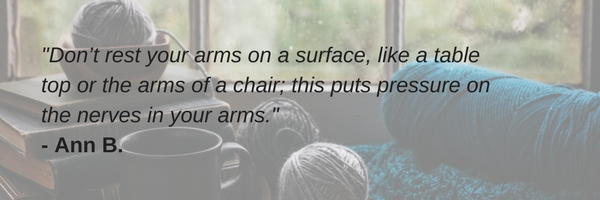29 Tips for Avoiding Knitting Pain

If you've been knitting for a long time, you probably know the perils of knitting pain. There are plenty of ways to prevent and avoid it altogether, but sometimes you just get too caught up in your work that you forget to take a break for your hands.
These reader-submitted tips for avoiding joint pain while knitting are some of the best pieces of advice we could find.
From taking regular breaks, stretching to using muscle-relaxing creams, you'll find out all the best tips from the experts -- real knitters like you and me! Say goodbye to tense hands, cramping muscles, and shoulder pain by following these simple, quick-and-easy tips.
As a knitter, one of the things I struggle with the most is keeping myself pain-free during an extended knitting session. Whether it's forgetting to stretch, not taking enough breaks or knitting tension problems, sometimes knitting leaves me feeling tired and sore. Joint pain and numbness during or after knitting is common, but it can be avoided with a few careful steps.
Because the readers of AllFreeKnitting are always a wealth of information when it comes to tips for beginner knitters, we turned to you for your best proven methods for avoiding knitting-related pain.
For more great projects like this, subscribe to our free email newsletter!
Tips for Avoiding Knitting Pain from Knitting Tension Problems
1. Make sure that you take frequent breaks! - Diana K.
2. When you get to the end of a row of a bigger project, rotate your wrists once counterclockwise and once clockwise. If it is a smaller project, do the same thing after 5 rows. - Becky C.
3. Make sure you take breaks, support your arms and use a hand brace. Take stretching breaks for your fingers, wrists and arms. - Linda R.
4. Keep your back straight and your shoulders down. - Brianna

6. Keep your back straight and your shoulders down. - Brianna
7. I wear a wrist brace at night to guarantee a pain-free day of knitting when I wake up. - Robin
8. I squeeze and release a small rubber ball a few times to relax and ease the tension in my hands and fingers. - Anna Marie G.
9. Stretch, stretch, stretch. Hold arm straight forward, palm down, pull your fingers up and back gently with opposite hand. Repeat with the other arm. Then palm up, push hand/arm down and back gently and repeat with the other arm. Also, make sure to get up and get the blood flowing in your legs and buttocks! Do some stretches while standing. And don't forget to drink plenty of water. Keep hydrated. - Kay
10. Take a break every 30-45 minutes and do some hand/wrist stretches. - Cynthia W.
12. Avoid painful fingertips by using flexible thimbles on each index finger while knitting. - Jeannie M.
13. Flex your fingers every so often and make sure to put your knitting down for a few minutes. Make sure your elbows are supported to avoid pain or too much muscle tension. Free movement of your arms, I think, is crucial. - B.J.M.
14. Keep hands nimble by using a squeeze toy, like a can of very thick putty. - Wil B.
15. Shake your hands out to loosen them up after knitting a while. - Jessica K.
16. Put a pillow or throw on my lap when I settle in for a long knitting session. - Mariann F.
17. As soon as you feel a tingling in your arms, stop and do something else for a few minutes - change the clothes in the washer to the dryer or do any chore that only takes a few minutes. - Mary T.
19. Set a timer for every hour and make sure to get up, stretch, get a drink or take a bathroom break! - Becky R.
20. Support your arms on a pillow to relieve any pull or strain in your shoulders. - Joyce D.
21. Change the way you hold your needles to reduce tension. For example, avoid knitting with long needles; they can be too heavy and can cause more stress on the hands. If your project requires longer needles, make sure they are interchangeable ones. If you have a lot of stress on your hands, try switching to the Continental knitting method; this is proven to be easier on the hands. Lastly, alter the way you hold your yarn. For knitting: I call my hold the hook/chop stick method. My right hand looks like I am holding a crochet hook in the underhanded position, and my left looks like I am holding chopsticks with the yarn as the top stick and the needle as the bottom stick. For crochet, do the same thing, except the left hand has the yarn as the top stick, and I hold the work in the bottom stick position. - Jessica N.
22. Cut off the tips of a pair of battery-operated warming gloves and wear them as crafters gloves while knitting to reduce pain. - Merri Orgeman
24. Wear fingerless craft gloves that have a good, supporting wristband while you’re doing your handwork. if your fingers numb or your wrists hurt, use your fave pain relief cream and rub it on your wrists. - Ritainalaska
25. Before knitting, and as often as you feel necessary, put your fingertips together and push them against each other, as if a spider is doing pushups on a mirror. Also rotate wrists often to loosen them up. Having a comfortable place to rest your arms is also important as well as making sure you maintain good posture. - Beverlee C.
26. Comfortable chair, good lighting, frequent breaks to stretch shoulders, neck, arms, and fingers and wooden needles! - Lynda B.
27. Two things that have helped me: concentrating on learning to crochet/knit in a more relaxed way (not keeping tension in my hands and arms and paying attention to position), and using a proper chair that supports my back, neck, and arms.- Nancy
29. Do daily exercises using rubber putty and a tension band. - Lena C.
30. I use Voltaren rub. - Diane
31. Tiger Balm muscle rub is very nice to use on your sore spots, even Bengay helps! Also, those Ace wraps for wrists work well. - Joann
While knitting does come with a little bit of pain, there are plenty of health benefits to knitting. Check them out here:
How do you avoid knitting pain?
Let us know in the comments

